
Roots
Consider, for a moment, the very essence of a strand of textured hair—its delicate yet resilient structure, spiraling outward in myriad ways, each coil telling a tale of resilience and adaptation. For the Himba people of Namibia, this narrative is not merely metaphorical; it is quite literally inscribed onto their beings, particularly through the ancestral practices shaping their hair wellness. This deeply rooted connection, a living archive of wisdom passed from one generation to the next, reveals a profound understanding of hair as a cultural marker, a shield against nature’s intense elements, and a canvas for identity. To truly appreciate this heritage, one must peel back layers, much like the gentle uncoiling of a coil, to examine the elemental biology and the ancient practices that birthed a system of care so enduring.
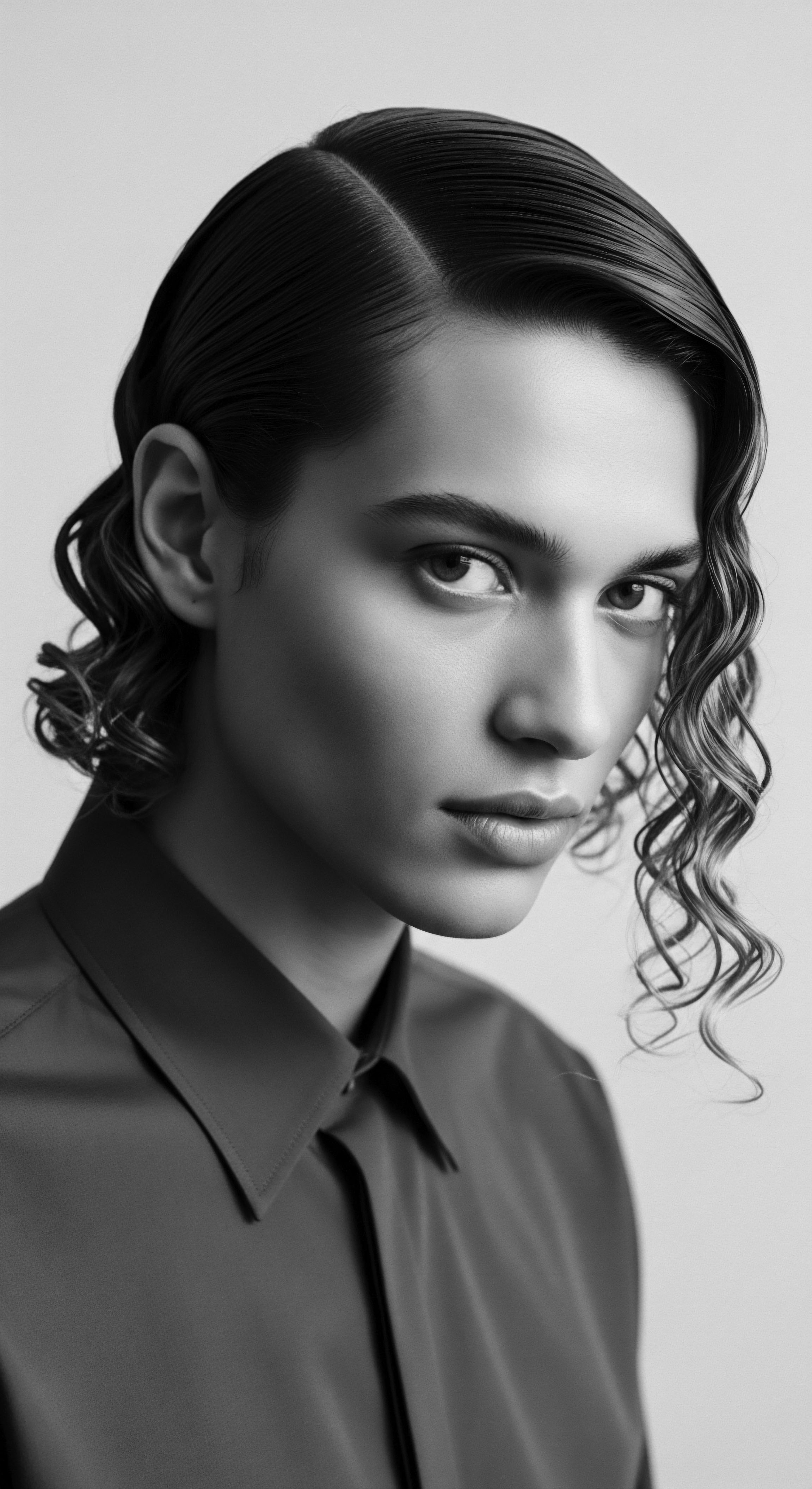
Textured Hair’s Ancient Architecture
The unique configuration of afro-textured hair, with its elliptical follicle shape and characteristic coiling, is widely understood by evolutionary biologists as a protective adaptation to environments with intense solar radiation. This ancestral blueprint, a heritage of survival, offers natural insulation and helps regulate scalp temperature. The Himba, living in the harsh, arid landscapes of Namibia, exemplify this adaptation.
Their textured hair, rather than being seen as a challenge, is honored as a gift from their environment, its structure dictating the very methods of its care. The curls, each a miniature helix, are designed for the very air that moves through them, providing a cool embrace against the desert sun.
The intricate coil patterns of textured hair bear witness to an ancient biological adaptation, a living heritage designed for resilience in challenging climates.
Hair, in its most elemental form, is a protein filament, primarily composed of Keratin. Yet, the arrangement of these proteins, the distribution of disulfide bonds, and the geometry of the hair follicle itself profoundly influence its appearance and needs. Himba practices acknowledge this intrinsic structure, working with the hair’s natural inclinations rather than against them.
The care rituals they observe are not arbitrary; they arise from centuries of close observation of both the hair itself and the environment it inhabits. This deep knowledge, passed down through oral tradition and lived experience, represents a profound biological understanding, centuries before modern science articulated the specifics of UV filtration or moisture barrier function.
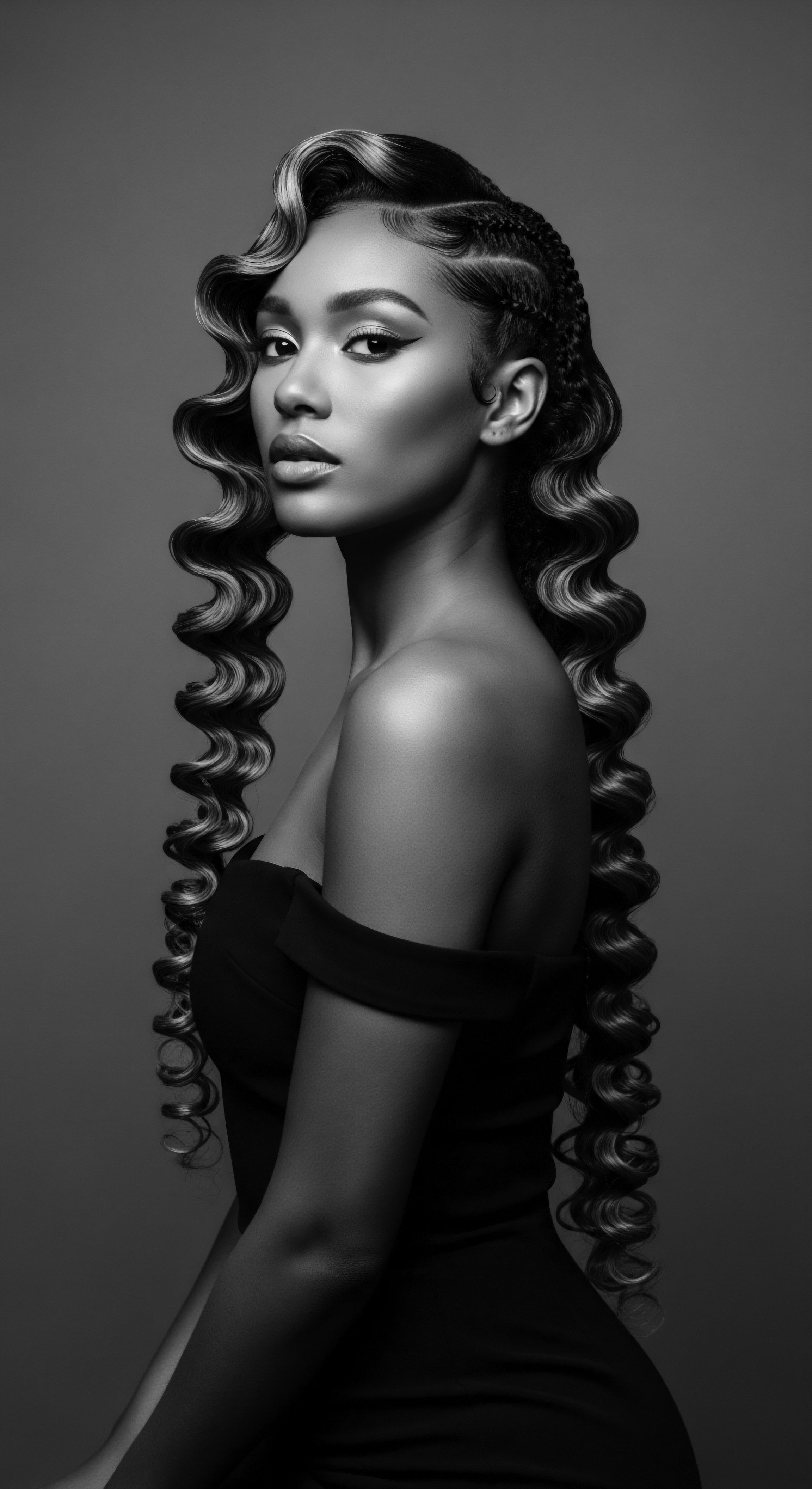
The Himba’s Foundational Lexicon of Care
The cornerstone of Himba textured hair wellness rests upon a distinct material known as Otjize. This preparation, far more than a simple cosmetic, embodies a holistic approach to wellbeing, safeguarding both hair and skin. It is a carefully blended paste of butterfat, often from cattle, and finely ground red ochre pigment .
The ochre, rich in iron oxides, lends the hair its characteristic reddish-brown hue, a color symbolizing the earth’s life-giving vitality and the blood that courses through their veins . Often, this compound is perfumed with aromatic resins, such as those from the Omuzumba Shrub (Commiphora multijuga), adding a sensory dimension to its protective properties .
This traditional formulation serves several critical functions. Firstly, the butterfat provides an occlusive layer, sealing in moisture and preventing evaporation in the extremely dry desert air. This aligns with modern scientific understanding of lipid barriers in hair care, demonstrating a sophisticated ancestral grasp of emollient properties. Secondly, the red ochre acts as a natural sunblock.
A 2022 study by South African and French scientists published on otjize’s physical properties concluded that “such a red ochre exhibits an exceptional UV filtration and a significant IR reflectivity substantiating its effectiveness as an effective UV-blocking and solar heat IR reflector in support of the low skin cancer rate within the Namibian Himba community” . This research validates centuries of lived Himba experience, confirming their ingenious application of natural resources for photoprotection .

What Ancestral Elements Formulate Himba Hair Protection?
The components of otjize speak volumes about the Himba’s reliance on their direct environment and their pastoralist heritage. The ingredients are not sought from distant lands, but harvested from their immediate surroundings, reflecting a sustainable interaction with nature.
- Butterfat ❉ Sourced primarily from their cattle, a central element of Himba wealth and sustenance, providing deep moisture and emollient qualities .
- Red Ochre ❉ A naturally occurring red clay pigment, usually hematite, offering both a distinctive color and protective qualities against the sun’s harsh ultraviolet rays .
- Aromatic Resins ❉ Typically from local shrubs like Commiphora multijuga (omuzumba), lending a pleasing scent and potentially antimicrobial benefits .
- Ash ❉ Some accounts mention the occasional inclusion of wood ash, which, when combined with butterfat and water (during rare washes), can create a weak alkaline solution that acts as a gentle cleanser .
This deliberate combination of natural elements transforms a basic hair application into a sophisticated wellness practice, a testament to ancestral ingenuity. The wisdom passed through generations allowed for the creation of a compound that directly addresses the unique needs of textured hair in an arid environment, providing hydration, sun protection, and a medium for cultural expression.

Ritual
Beyond the fundamental science and chosen elements, the practices shaping Himba textured hair wellness reside in the living, breathing rituals that form the rhythm of daily life. These are not isolated acts of grooming; rather, they are communal engagements, expressions of social standing, and quiet moments of self-care, all profoundly influenced by a shared heritage. The application of otjize and the styling of hair become a tender thread, interweaving personal appearance with community bonds and ancestral continuity.
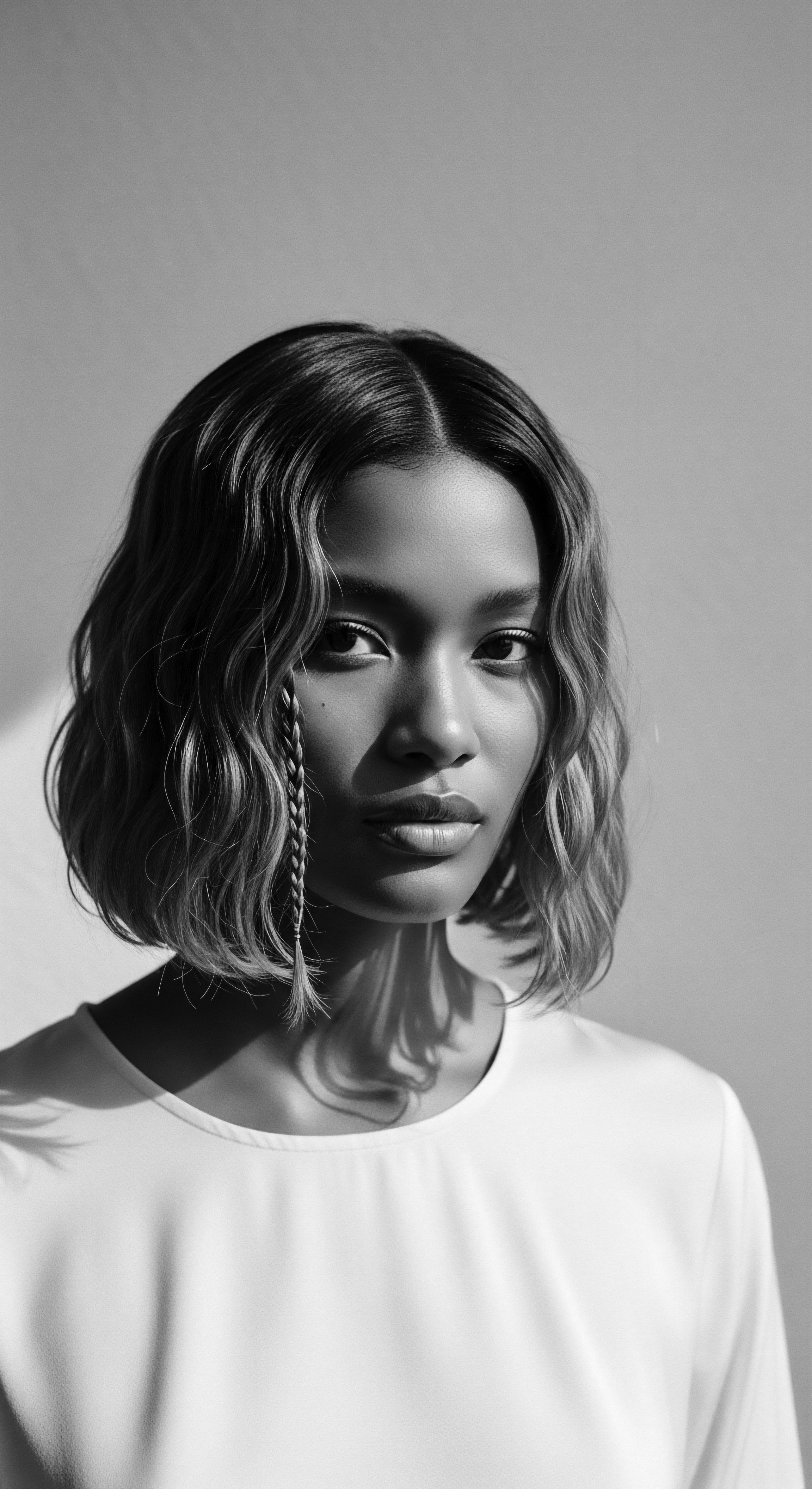
Daily Adornment and Communal Hands
For Himba women, the daily application of otjize is a morning ritual, a moment of purposeful engagement with their physical form and cultural identity . This is often a communal activity, with close relatives spending hours together, meticulously applying the mixture and shaping the elaborate hairstyles . This shared practice underscores the deep social connections within the Himba community, where knowledge and techniques are transmitted through generations, hand to hand, elder to youth . It is a tangible way in which social connections are fortified, ensuring the perpetuation of practices essential to their wellbeing and heritage .
The hairstyles themselves are a vibrant language, speaking volumes without a spoken word. They convey the wearer’s age, marital status, wealth, and rank within the community . For instance, young girls traditionally wear two forward-facing braids, known as Ozondato, symbolizing their innocence and childhood .
As a girl approaches puberty, these braids might be swept back or new styles introduced, signifying her readiness for marriage . Upon marriage, or after bearing a child, a woman adopts more elaborate styles, often incorporating an ornate headpiece called the Erembe, crafted from sheep or goatskin, into which many streams of otjize-coated braids are woven .
Himba hair rituals transcend mere beauty; they are intricate social dialogues, speaking of identity, status, and community bonds through careful artistry.
This intricate system of hair adornment ensures that individual appearance is deeply connected to collective cultural expression. The very act of styling becomes a form of storytelling, a public declaration of one’s journey through life, always anchored in shared heritage. The addition of external elements like hay, goat hair, or artificial extensions into the braids further enhances these elaborate designs, reflecting a creative adaptation of available resources to serve cultural aesthetic and symbolic purposes .
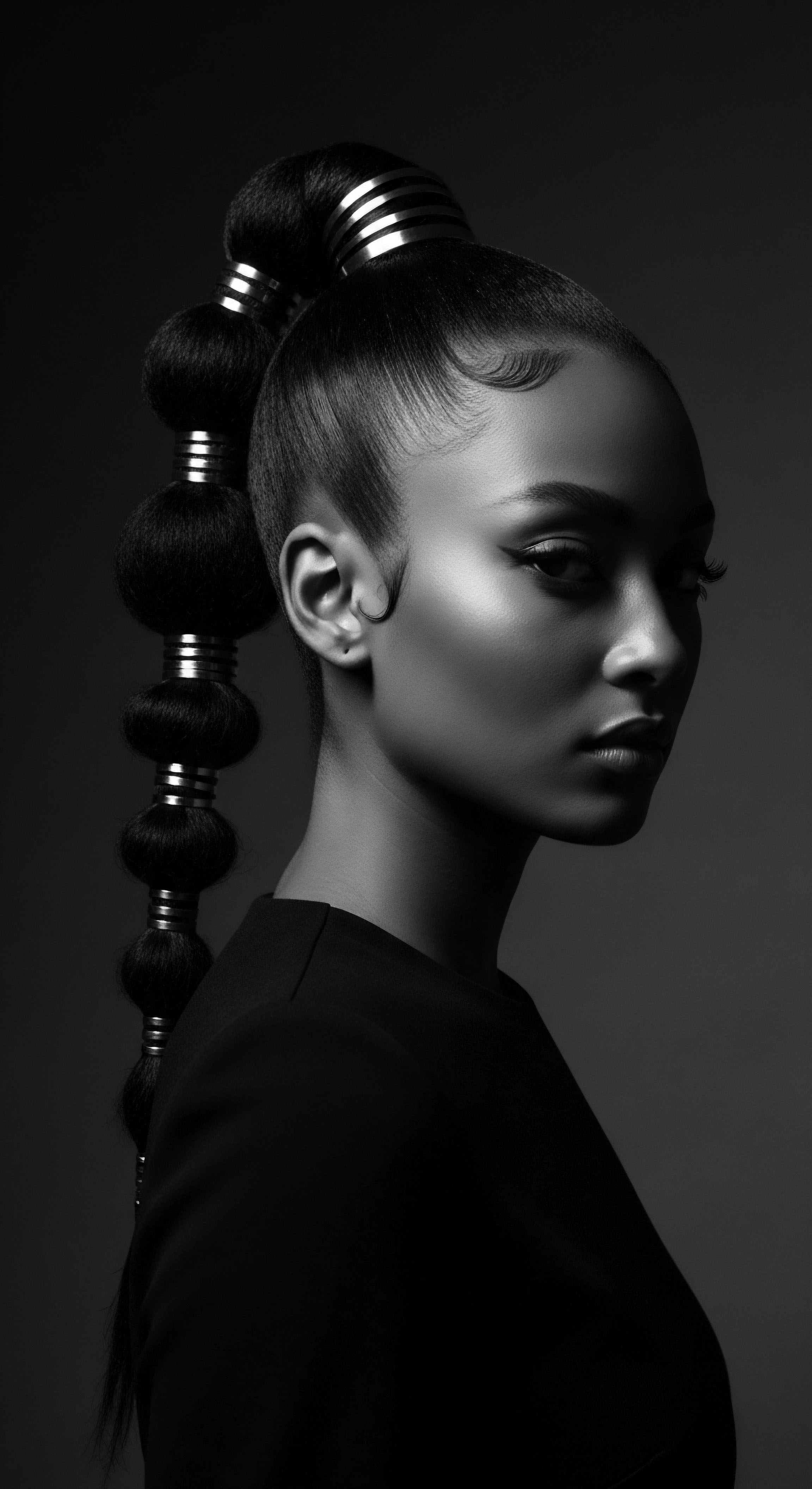
Cleansing and Environmental Consciousness
In a region where water is a scarcity, the Himba have ingeniously developed hygiene practices that honor their environment while maintaining hair health . Traditional cleansing does not involve copious amounts of water. Instead, Himba women often employ a “smoke bath” ritual, using aromatic resins, such as Namibian Myrrh (Omumbiri), or the wood shavings of Mopane, creating a perfumed smoke . They sit draped in a blanket, allowing the smoke to cleanse their skin and hair, offering antimicrobial benefits and a pleasant scent .
This smoke cleansing is complemented by the self-exfoliating nature of otjize. As the paste dries and flakes off the hair and skin over time, it carries away dirt, dead skin cells, and environmental impurities . For more thorough hair cleansing, wood ash is used .
When mixed with water and the butterfat residual from otjize, the wood ash creates a weak alkali solution, effectively acting as a mild, natural soap to cleanse the hair and scalp . This demonstrates an astute understanding of chemical principles in a resource-limited setting, a wisdom born from generations of observation and ingenuity.
| Ancestral Practice Otjize application |
| Traditional Purpose Moisture, sun protection, identity, aesthetic |
| Underlying Mechanism (Modern Insight) Lipid barrier formation, UV filtration (ferrous oxide), symbolic cultural continuity |
| Ancestral Practice Smoke baths |
| Traditional Purpose Hygiene, scent, spiritual cleansing |
| Underlying Mechanism (Modern Insight) Antimicrobial properties of resins, indirect cleansing, personal scenting |
| Ancestral Practice Wood ash cleansing |
| Traditional Purpose Hair and scalp purification |
| Underlying Mechanism (Modern Insight) Alkaline saponification of butterfat, gentle removal of impurities |
| Ancestral Practice Communal hair styling |
| Traditional Purpose Social bonding, knowledge transmission |
| Underlying Mechanism (Modern Insight) Reinforcement of community ties, intergenerational learning, cultural preservation |
| Ancestral Practice These practices demonstrate a remarkable blend of practical efficacy and profound cultural meaning, a testament to inherited knowledge. |
The Himba’s care methods are not merely functional; they are deeply spiritual. The use of natural elements from their ancestral lands creates a profound sense of oneness with their surroundings and their heritage . This spiritual connection to self-care, as one source notes, is seen as a way to honor ancestors and connect with the divine, a celebration of cultural identity that transcends mere external appearances . It speaks to a holistic wellness philosophy where physical adornment is inextricably linked to inner wellbeing and a legacy of wisdom.

Relay
The lineage of Himba textured hair wellness, far from being static, continues to play a dynamic part in shaping identity and future generations. The ancestral practices, steeped in centuries of wisdom, serve as a potent symbol of resilience and cultural continuity, particularly within the broader context of Black and mixed-race experiences where hair has often been politicized and scrutinized. This unbound helix of heritage spirals forward, adapting, enduring, and asserting its profound significance in a rapidly changing world.
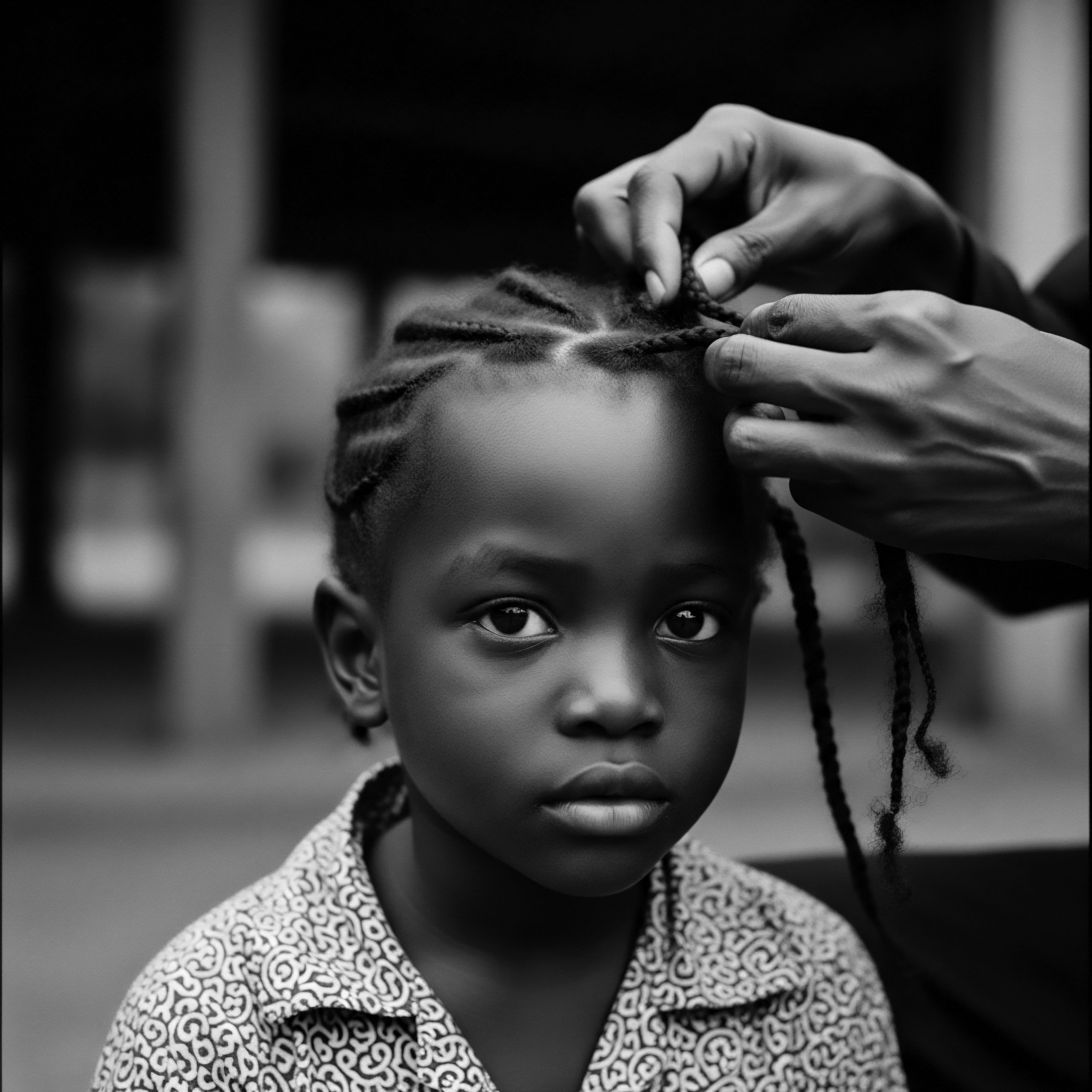
How Does Himba Hair Symbolize Identity and Status?
Hair, across numerous African societies, has historically served as a powerful signifier of individual and communal identity, social rank, marital status, and spiritual beliefs . For the Himba, this symbolism is visually explicit and meticulously maintained. The intricate hairstyles, formed with the distinctive otjize paste, are not simply aesthetic choices; they are a visual autobiography, a narrative of one’s life stage and belonging .
- Childhood ❉ Young Himba boys typically have a single braid extending to the back of the head, while young girls wear two braids flowing forward over their eyes . Some clans may even shave the heads of infants, leaving only a small crop on the crown . These initial styles publicly declare a child’s early lineage and innocence.
- Adolescence and Puberty ❉ As girls approach puberty, their hairstyles may shift, with braids being tied backward or styled to cover the face, often signalling a period of transition or readiness for marriage . This deliberate veiling can deter unwanted male attention, creating a space for personal transformation.
- Marriage and Motherhood ❉ A profound shift occurs upon marriage or after the birth of a child. Women adopt the Erembe headdress, an elaborate leather crown integrated with their many otjize-coated braids . This style powerfully indicates maturity, marital status, and often, fertility, a deeply respected attribute within the Himba community .
The act of wearing these culturally specific styles reinforces communal belonging and preserves a unique visual language that has resisted external pressures. This steadfast adherence to ancestral hair practices contrasts sharply with the historical subjugation of Black hair in other contexts, where textured hair was often denigrated or forced into European aesthetic norms during periods of slavery and colonialism . The Himba’s unwavering commitment to their hair traditions, therefore, stands as a testament to cultural autonomy and resistance.

What Insights Do Himba Practices Offer for Modern Textured Hair Wellness?
The ancestral practices of the Himba offer invaluable insights that resonate with contemporary textured hair wellness philosophies. Their traditional methods, refined over centuries of interaction with the environment and observation of hair’s natural properties, provide a compelling blueprint for holistic care.
For instance, the emphasis on lipid-rich applications, like otjize’s butterfat, speaks directly to the need for sustained moisture in textured hair, which is prone to dryness due to its coiled structure and fewer cuticle layers . Modern hair science validates the role of emollients in reducing breakage and maintaining suppleness. Similarly, the Himba’s use of red ochre as a sun protectant highlights an early recognition of environmental stressors on hair and scalp health. The scientific confirmation of ochre’s UV-blocking properties (as noted by the 2022 study) reveals an ancient empirical wisdom that predates modern dermatological advancements .
| Himba Practice (Ancestral Wisdom) Otjize (Butterfat + Ochre) |
| Modern Scientific Relevance Deep conditioning, UV protection, environmental barrier (mimics modern leave-ins, sunscreens for hair) |
| Himba Practice (Ancestral Wisdom) Smoke Cleansing |
| Modern Scientific Relevance Antimicrobial benefits from botanical resins, water-saving hygiene (parallels dry shampoos, botanical scalp treatments) |
| Himba Practice (Ancestral Wisdom) Communal Styling |
| Modern Scientific Relevance Mental wellbeing, cultural connection, knowledge transfer (recognizes social support in wellness, importance of tradition) |
| Himba Practice (Ancestral Wisdom) Hair as Status Marker |
| Modern Scientific Relevance Hair as a powerful identity tool, self-expression, and cultural pride (informs modern natural hair movements, identity affirmation) |
| Himba Practice (Ancestral Wisdom) The Himba's living heritage provides a profound historical lens through which to comprehend the enduring requirements and symbolic value of textured hair. |
Moreover, the communal aspect of Himba hair care—the gathering of women to groom one another—serves as a powerful reminder of the social and psychological dimensions of wellness . In a world increasingly fragmented, the ancestral practice of shared care fosters bonds, transmits cultural knowledge, and reinforces a sense of collective identity. This communal support contrasts with the often individualistic approach of modern beauty routines, inviting a deeper consideration of how shared experience contributes to holistic wellbeing.
The Himba approach also offers a compelling case study against common modern notions about the application of “raw oils and butters” on textured hair. While some contemporary hair discourse suggests avoiding these, the Himba, along with other African groups like the Basara tribe with their Chebe mixture or Ethiopian and Somali communities utilizing “hair butter” (ghee), have for millennia achieved impressive length retention and hair health by directly applying such substances . This historical evidence suggests that when formulated and applied within an ancestral system adapted to specific environmental and hair characteristics, natural fats and clays can be highly beneficial, challenging overly generalized modern prohibitions. It speaks to the critical importance of context and heritage in defining effective hair care.
Understanding the Himba’s practices extends beyond mere academic interest; it becomes a dialogue with the past, a recognition of ingenuity, and a guide for contemporary hair wellness rooted in heritage. Their rituals remind us that the solutions for our textured hair’s wellbeing often lie within the profound wisdom passed down through generations, echoed in the very coils that crown us.
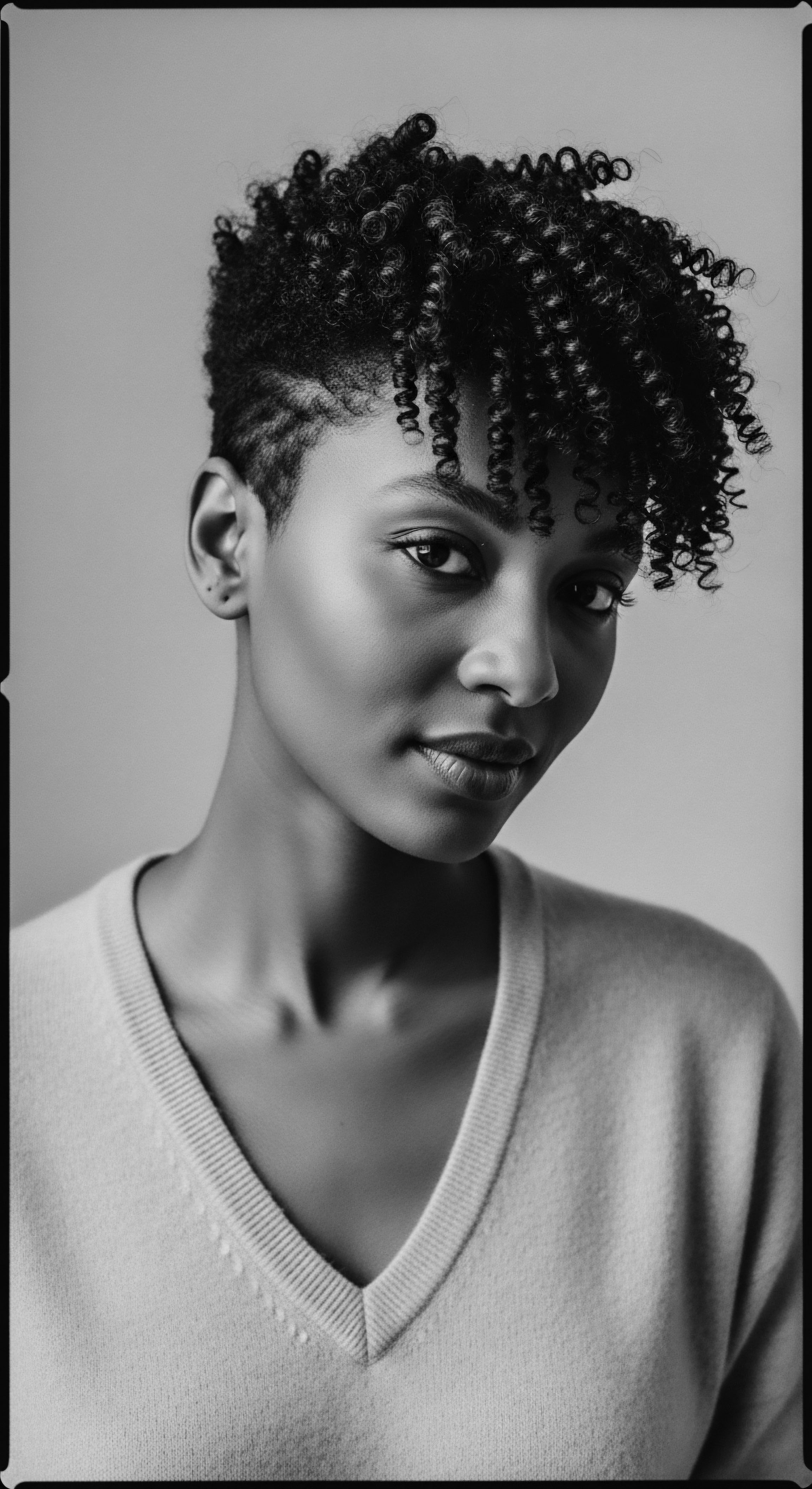
Reflection
Standing at the confluence of ancient wisdom and modern understanding, the ancestral practices that shape Himba textured hair wellness serve as a powerful testament to the ‘Soul of a Strand’ ethos. It is a philosophy that sees hair not as a mere appendage, but as a living repository of history, culture, and personal journey. The Himba, through their enduring commitment to otjize and their intricate styling traditions, offer a tangible, breathing archive of this profound connection. Their hair, cloaked in the earth’s red embrace, tells stories of environmental adaptation, social hierarchy, and unwavering identity, all while defying the harsh realities of the Namib Desert.
The meticulous crafting of otjize, the communal hands that apply it, and the symbolic language spoken through each braid and adornment, echo a universal truth ❉ true hair wellness extends far beyond superficial grooming. It is a holistic endeavor, inextricably linked to one’s environment, community, and ancestral lineage. For those of us navigating the complex landscapes of textured hair in a modern world, the Himba provide a luminous example of working in harmony with our hair’s inherent nature, drawing from the richness of our past to nourish our present.
Their practices beckon us to remember that the most potent elixirs for our coils and kinks often reside in the ancient earth, the communal spirit, and the deep, unwavering reverence for who we are and from whom we descend. The heritage of textured hair, as exemplified by the Himba, is not a relic of bygone days; it is a dynamic, living legacy, offering guidance and inspiration for the unbound helix of our future.

References
- Infringe. “Himba Hair Rituals.” INFRINGE.
- Alkebulan Mojo. “The Enigmatic Hair Rituals of the Himba Tribe ❉ Unlocking the Secrets to Long, Luscious Locks.” Alkebulan Mojo, 2025.
- Ally, Alegra. “One Month with the Himba.” Africa Geographic, 2014.
- The Guardian Nigeria News. “Otjize ❉ The Red Beauty Miracle Of The Himba People.” The Guardian Nigeria News, 2022.
- Reddit. “No raw oils and butters vs. Traditional African hair care? ❉ r/Naturalhair.” Reddit, 2021.
- Africa Safaris. “Himba Tribe.” Africa Safaris, 2024.
- Trad Magazine. “Otjize ❉ Earth’s Beauty.” Trad Magazine, 2021.
- Hadithi Africa. “Namibia’s Himba tribeswomen and their elaborate hairdos.” Hadithi Africa, 2019.
- 22 Ayur. “The Ancient Natural Ways of Hair Care Across Continents.” 22 Ayur.
- Szydlik, Aga. “Himba | Culture, Life, and Otjize.” Aga Szydlik | Photography.
- Dr.UGro Gashee. “Red Ochre as a Skin and Hair Sunblock an Old Himba Discovery.” Dr.UGro Gashee, 2020.
- Africa Travel. “Cultural Spotlight ❉ The Himba Of Namibia.” Africa Travel.
- Wikipedia. “Otjize.” Wikipedia.
- Bebrų Kosmetika. “The Power of Hair in African Folklore ❉ Rituals and Traditions.” Bebrų Kosmetika, 2024.
- Da Costa, Diane. “History of the Natural Texture Hair Movement.”
- Sellox Blog. “Ancient African Hair Growth Secrets For Healthy Hair.” Sellox Blog, 2021.
- Afriklens. “African Hairstyles ❉ Cultural Significance and Legacy.” Afriklens, 2024.
- J.T Safaris. “The Himba Culture In Namibia.” J.T Safaris, 2024.
- Delicious Living. “5 beauty ingredients from Africa.” Delicious Living, 2014.
- Art In Early Childhood. “Aesthetic representations among Himba people in Namibia.”
- Pure Love Artisan Sk. “The Age-Old Beauty Rituals of the Himba Tribe.” Pure Love Artisan Sk, 2024.
- EBSCO Research Starters. “Afro-textured hair.” EBSCO Research Starters.
- Black History Month. “Unlocking Ancient African Beauty Traditions ❉ A Tribute to Black History Month with Timeless Indigenous Ingredients for Radiant Skin and Hair.” Black History Month, 2024.
- Kilburn & Strode. “Afro-texture ❉ a hair-story.” Kilburn & Strode, 2021.
- Okorafor, Nnedi. “Understanding the Himba Culture through Binti.”
- The Diamondback. “The evolution of textured hair care and styling, a brief history.” The Diamondback, 2022.
- Our Habitas. “Healing Power of Himba.” Our Habitas.
- Colleen. “The History of Textured Hair.” Colleen, 2020.
- Department of Justice. “Namibia ❉ Traditions and practices of the Himba ethnic group of the Ovaherero, including.” Department of Justice, 2021.
- Wikipedia. “Himba people.” Wikipedia.
- Bushguide 101. “Himba smoke shower.” Bushguide 101.
- Lafforgue, Eric. “Himbas.” Eric Lafforgue.
- Green People UK. “Myrrh – the incredible story of the Himba tribe.” Green People UK.
- ResearchGate. “(a) Traditional preparation of the Red Ochre pigment by the Himba. ” ResearchGate.
